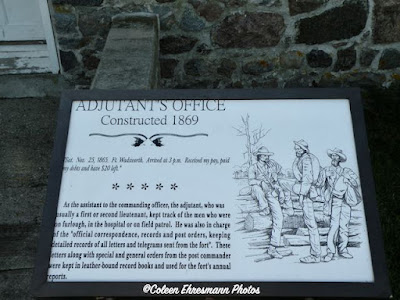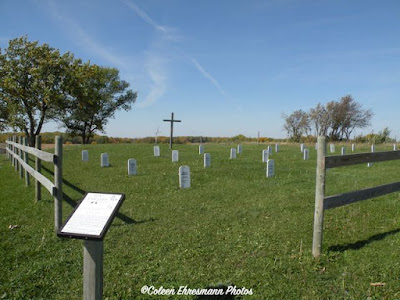On our way home from our North Dakota geocaching adventure, we also stopped at Fort Sisseton, also because of geocaching. I have been to the fort with school kids, to attend a play or maybe a melodrama, and once or twice just to visit. It always intrigues me.
Named after the nearby Sisseton Indian Tribe, this historic fort is now a picturesque state park that unfolds the area's past. Walk the grounds where the officers' quarters, stone barracks, powder magazine, guard house, and other buildings that remain from the time of the western frontier.
This 1864 fort, atop the Coteau des Prairies (or hills of the prairies), was originally a frontier army outpost called Fort Wadsworth. The site was chosen because it provided a strong natural defense, an ample supply of lime and clay for making bricks, an abundance of lake water for drinking and a thick stand of trees for timber and fuel.
I have not known much about the history of the buildings as I have only entered one or two of them. But I found a most interesting story about the history of the fort after it was abandoned by the US army. Take the time to read The Fort Sisseton Kid.
Yes, there was some rebuilding through the WPA program, but the most interesting part is from the 1930s to 1959 when it became a state park.
At the height of activity the fort housed 150 to 200 infantry men assigned to protect the settlers and miners traveling through the area.
Andrew enlisted at age 14 and kept a diary while stationed at Fort Wadsworth/Fort Sisseton. His comments on the info signs around the fort make for very interesting reading. My photo tour will be counter clock-wise.
School House and Library
Hospital
notice the widow's walk
The fort also kept records and reported the weather:
“On the 29th of July 1873, a terrific storm of wind, hail, and rain broke over the
fort, which seemed to have originated but a few minutes before in a comparatively small,
dark cloud. In a few minutes the commanding officer’s quarters, one of the company
barracks, the guardhouse, the adjutant’s office, the Government stables, and the old
buildings outside the fort, formerly used as quarters for scouts, were either wholly or
partially unroofed. Every window exposed to the storm was broken, and the buildings
were deluged with water, which caused the plastering to fall. The hospital had one
hundred and eighteen panes of glass broken, and the produce of the gardens was
destroyed.”
Doctor's Quarters
West of this residence are depressions in the ground marking the hospital toilets and the death house, where bodies were stored when the ground was frozen.
duties of the doctor
no photo of the commanders quarters
looks much like the info sign photo
Officers' Quarters
Andrew felt Fort Sisseton was the worst place he had ever been stationed
Adjutant's Office
duties of the Adjutant
Magazine
also showing the moat and earthen works 'wall' of the fort
originally the berm was 8 feet high
inside the magazine
arched brick ceiling
A stone and brick magazine was one of the few structures in near-original condition by the 1930s.
Guard House
Napoleon
range of 2000 yards, moved by a team of 6 mules
5 or 6 men to load and shoot the cannon
South Barracks
designed to house 150 men
North Barracks
Remember: Click on any photo to enlarge
now housing the Visitors' Center and staff offices
Stable/Barn
The 35 x 219–foot stone stable, which contains 78 stalls, originally had a gable roof but was redesigned to the present gambrel roof during the WPA restoration.
used to store equipment
Also outside the 'fort's berm was a 3-room root cellar that stored produce grown in the fort’s three gardens.
I did not know the fort had a cemetery, so this was my first visit to the hill. All of the interred have been moved to the Custer National Cemetery at Little Bighorn Battlefield in Montana.
As we were driving away, I noticed the name of a woman on a headstone. So I snapped a photo and then when looking at my photos realize Louisa's headstone is in the above photo. Wish I had noticed when I was there. Who was she? How did she die? Interesting to note, I read somewhere the woman/women who died in childbirth at the fort. That is confirmed on the Post Cemetery link above. Also interesting...Louisa is on the list of those buried, but Betty is not. Hmmmm.
The fort was surrounded by lakes on 3 sides. There is a bit of water showing behind the sign of the first photo and a bit of water below the cemetery hill and some along the south side. Certainly not as much water today as there was in 1864.































No comments:
Post a Comment
Thanks for your comments!